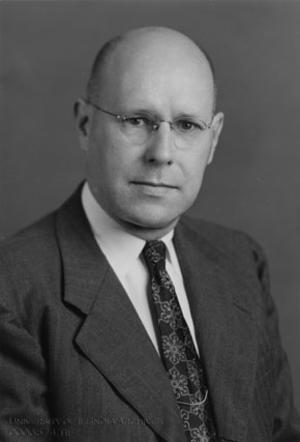
John Christian Bailar, Jr. was born in Golden, Colorado in 1904 and received his degrees in chemistry from Colorado and Michigan. He became an instructor at the University of Illinois in 1928 and began a sixty-three year career in Illinois - Department of Chemistry. He became associate professor in 1930 and full professor in 1943. Although interested in organic isomerism as a graduate student, it was while teaching a general chemistry course that he realized that isomerism, the occurrence of different compounds with the same chemical composition, is a general phenomenon that could also exist among inorganic compounds. He trained several generations of coordination chemists (ninety doctorates, thirty-eight postdoctoral fellows, and numerous bachelor’s and master’s degree candidates), making the University of Illinois, already well-known for organic chemistry in the United States, equally renowned for inorganic chemistry.
Bailar was instrumental in establishing the monograph, Inorganic Syntheses, in 1939. He helped establish the ACS Division of Inorganic Chemistry in 1957 and became its first chairman. In 1962, Inorganic Chemistry, the first such journal in the English language, began publication, largely through his efforts. Bailar won the Priestley Medal , the highest honor the American Chemical Society can bestow, in 1964, and served as President of the American Chemical Society in 1959.
The resurgence of inorganic chemistry after World War II, known as "the renaissance of inorganic chemistry," owed much to the pioneering efforts of Bailar, who also, more than any other person, was responsible for the advancement of coordination chemistry in the United States. Bailar is widely acknowledged as the "father of American coordination chemistry."
One of his most significant achievements was his first work on coordination chemistry in 1934 with senior undergraduate student, Robert W. Auten, which established the inorganic counter-part of the well-known organic Walden inversion reaction. This work was the first installment in a 37-part series, "The Stereochemistry of Complex Compounds," issued from 1934-1985. He co-authored (1959) with Nobel laureate (1990) Elias J. Corey a classic article on octahedral complexes that led to applications of conformational analysis to coordination compounds.
1. Coord. Chem. Rev. 1993, 128, 1-48.
2. McGraw-Hill Modern Scientists and Engineers; McGraw-Hill: 1980; vol. 1, p42.
3. Chem. Eng. News 1991, 69(43), 46-47.
4. The Hexagon 1972, 101-104.
5. University of Illinois School of Chemical Sciences Alumni News Fall 1991 (insert).
6. Inorg. Chem. 1992, 31, 3183-3184.
7. Am. Chem. Soc. Symp. Ser. 1994, 565, 74-80.
8. Coord. Chem. Rev. 1990, 106, 1-23.